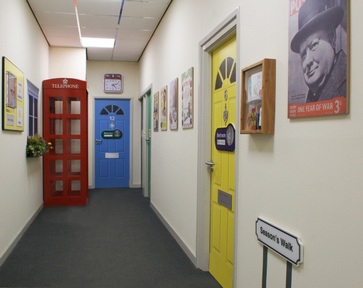| The Crystal Ball - J W Waterhouse |
Their number 1 is ‘Underground Attractions’ and they use as
examples, Iceland’s ‘Into the Glacier’, ‘Bounce Below’ in Wales, where you can
trampoline in a slate quarry and ‘Zip World Caverns’ where ‘daredevil tourists’
can go on zip wires and an assault course underground. My own slightly more
sedate example but still exciting will be the 20 minute ride on Mail Rail
opening in London in 2017 as part of the £25 million Postal Museum project, that
plays on the idea of underground secret tunnels, heritage and an immersive ride.
Number 3 is ‘Vintage’
with visitors dressing up for themed rides – they quote the
revamp of the New
York State Fair and the reopening of Dreamland at Margate UK
 |
| 1940s re-enactors see miliblog.co.uk |
Two perhaps potentially sensitive ones are number 5 - 'Dementia Friendly Design' ‘and number 6
– ‘Design for
Obesity’ or as their
headline says ‘Fat Planet’. The dementia friendly design approach is of course
just a further step on the access issue eg having typography that is readable
even for those with limited sight or even blind ie having Braille and having
well thought out and intelligent use of colours and patterns so as not to
confuse visitors. They quote the example of the ‘stick man’ and ‘stick woman’, frequently used for lavatories. If you cannot
remember what they mean, then they are not a lot of help! Mind you even I have
had a problem with some of the more arcane examples of stick people.
 |
| See carehome.co.uk |

Obesity is a major issue in the developed world and
Attractions Management expect to find
that attractions are increasingly catering for two distinct groups – obese
domestic and non obese tourist groups. The issue of over weight and large
visitors is an issue for all kinds of attractions impacting on such things as
seating, toilet cubicles, wider corridors and access in older heritage
buildings and places where the original occupants and users were smaller and
shorter anyway than the normal healthy 21st century adult.
Number 8 is ‘Invisibles’ -
sensors are integrated into the body to give a continuous data stream and
establish a complete picture of what is going with our responses..…this will
remove ‘the need to carry clunky devices’. This seems to be a variation on
their number 2 of ‘Customisation’ or
‘Feedback’ for rides where riders can influence their experience through
their breathing and heart rates.
Number 11 is ‘Africa ’ a continent which ‘will show exciting growth
over the next two decades, with the attractions industry ….as a driver for both
domestic and inbound tourism.’ Indeed
many countries in Africa have the assets to be potentially very wealthy with a
vibrant domestic and inbound tourism industry, Nigeria ,
South Africa and the Congo
No 12 is ‘Halal’
- Muslims spent US$149bn on international travel in 2013. AM forecast ‘further segregation in design
and in facilities…as the growth of halal tourism picks up pace.’ Quite how
Western audiences brought up in the Judeo-Christian tradition may react to this
in an attraction will be difficult to determine.
| See arcapplause.com |
No 13 is ‘Beacons’
- the technology is about to change the
way we look at attractions and open up opportunities for enhanced experience
design and (of course!) increased monetisation. Mind you I recall reading some
10 years ago, about the ability to send information to customers as they walk
past certain hotspots – maybe modern technology and the ubiquity of mobile
device will allow it to finally happen…
No 17 is ‘Tech
backlash’ – essentially we will be come fed up with digital technology and
visitors ‘will increasingly want to express themselves as sentient, physical, social beings’. Yes me
to – I’ve always be averse to walking around a museum or attraction with an
electronic gadget held to my ear and some disembodied voice telling me what I
should be looking at.
No 19 is ‘Retail Customisation’
and we are here already of course with ‘photo books,
3D printing etc and with
products tailored to individual customers. This is a development of the concept
developed by Chris Anderson in ‘The Long Tail’ published in 2006 – ‘How endless
choice is creating unlimited demand’ and brilliantly executed by the likes of
Amazon and Ebay where technology has created the ‘market of one individual’. Royal
Mail has been doing this for a while now with Smilers® - customised stamps which include your own
photo that you can buy on line and with a mobile app and special machines .
 |
| Royal Mail Group |
So those are just some of the Top 20 potential trends for
all those who work in the attractions industry to be aware of and perhaps react
to…